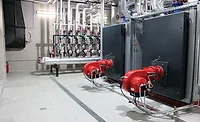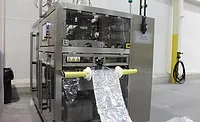Tech Update: Drying Equipment
Energy efficiency, controls offer processors better drying options
Drying equipment advances offer better control, energy efficiency.
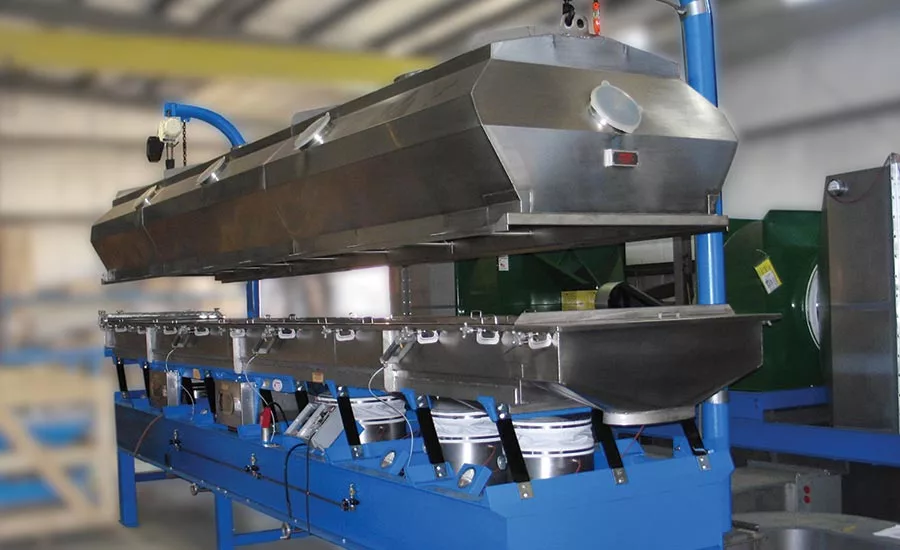
The Witte fluid-bed dryer allows it to be lifted out for cleaning and inspection to prevent cross-contamination and facilitate ease of cleaning. Source: The Witte Company.
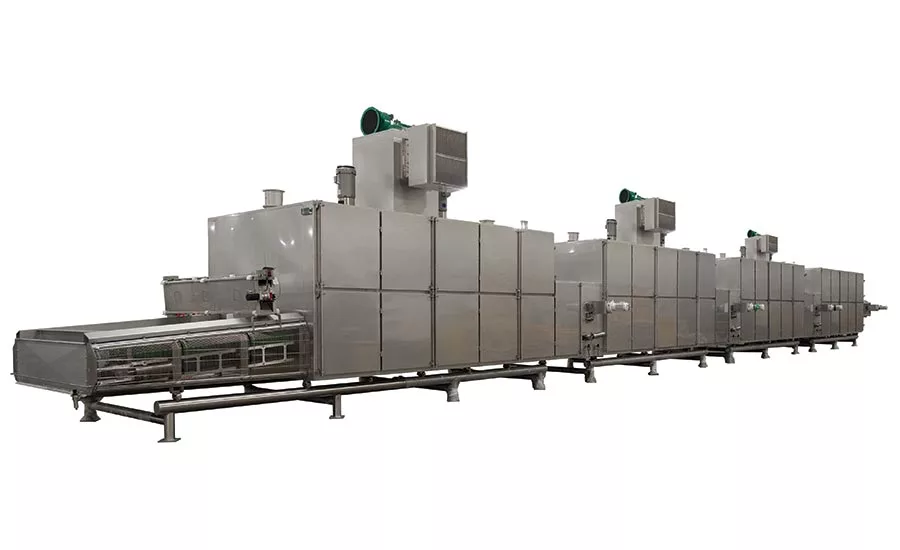
A Bühler Aeroglide Ceres Plus dryer is a hygienically designed dryer for use for coated cereal products. Source: Bühler Aeroglide.
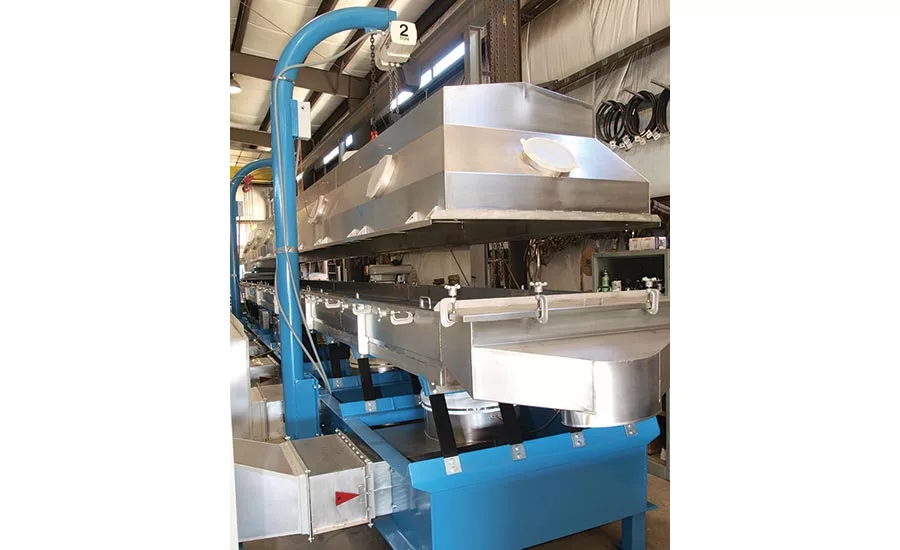
A motorized hoist raises the dryer and conveyor to allow access for cleaning and inspection. Source: The Witte Company.
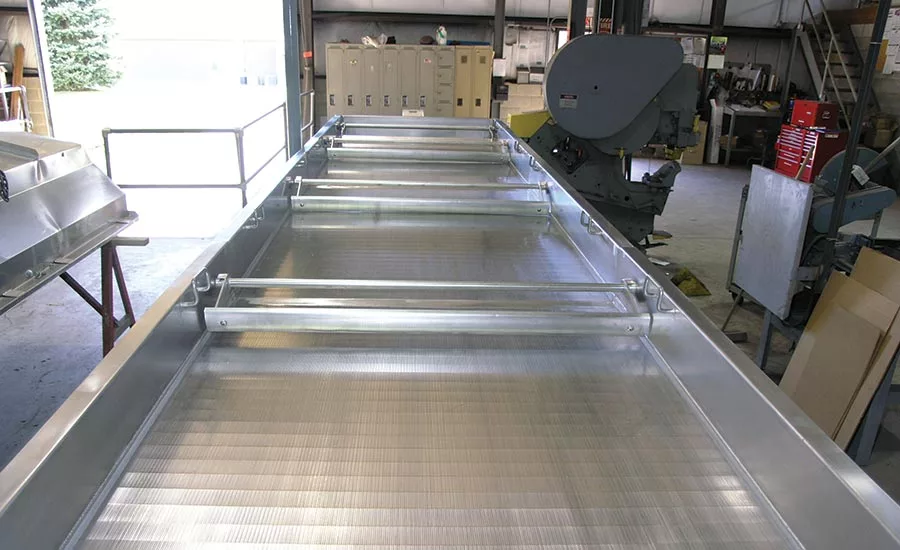
The conveyor bed of a Witte dryer. The conveyor is built with continuous construction, which cuts down on the number of welds needed and eliminates cracks and crevices that food can get caught in. Source: The Witte Company.
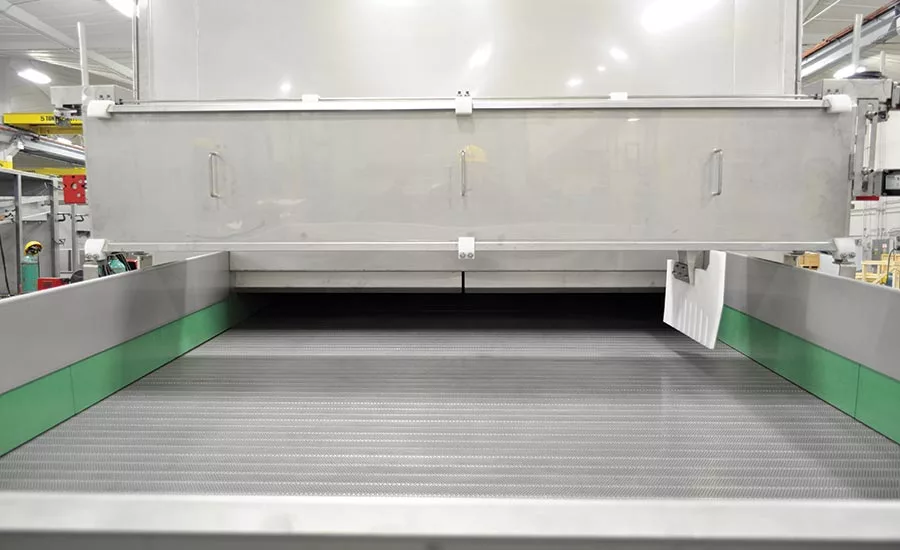
The conveyor belt of a Bühler Aeroglide Ceres Plus dryer. Source: Bühler Aeroglide.
Dryers are big, energy-gobbling machines that can last forever.
If you’re not convinced on that last part, consider this:
“We currently have a customer who purchased a Witte dryer 47 years ago,” says Larry Stoma, design engineer, The Witte Company. “It’s still running. The basic design, the basic theory of operation of that dryer 47 years ago is pretty much the same [as now].”
But what processors are looking for and prioritizing has certainly changed over the last 47 years and will continue to do so as things such as energy efficiency and automated controls continue to grow in importance. So, while the basic design of the dryer hasn’t changed much, the controls, components and operations of the machinery certainly have and will continue to do so.
As with other equipment, processors will need to be sure they are honestly evaluating what their needs are now and making their best effort to predict what their production needs will be in the near future. Those needs then have to be balanced with other considerations, because as much as production matters, the prospect of improving it is not going to result in a blank check.
“The first thing is, what needs to be upgraded?” says Nick Manley, marketing communications manager for Bühler Aeroglide. “What are you looking to get out of it that you’re not getting now? Are you increasing capacity? Are you increasing your moisture uniformity?”
Once this evaluation process is done, you can take it to the manufacturer and determine what best meets your needs. While some other equipment may be fairly standardized, dryers are not and can be customized in an almost unimaginable number of ways.
“We’re really more relying on the customer to tell us what it is they need rather than complying with a certain specification,” says Stoma.
One way that Tetra Pak is tackling how to determine what customers need and how to provide it is through using computational fluid dynamics (CFD). CFD offers the ability to analyze fluid flows and figure out ways to better design equipment to handle them.
“Rather than relying on R&D in customers’ plants to test ideas and designs, as is common in the industry, CFD allows for our designs to be tested before fabrication,” says Daniel Seckora, product and application manager of evaporation and drying for Tetra Pak.
By using CFD to test the designs before they’re actually built, equipment can be installed and brought online immediately.
In some cases, these tests can lead to an upgrade rather than purchasing a new piece of equipment. Regardless of whether it’s an upgrade or a replacement, processors want operations that are energy efficient, automated and sanitary, which all need to be considered carefully to maximize the benefits.
Automation
In the modern food plant, almost everything imaginable is becoming more automated, even dryers. As one of the most critical parts of any production operation, they offer the opportunity to collect reams of data, which can be analyzed and used to maximize efficient operations.
Big data comes into play here. While it’s a term that’s often misunderstood and, even more often misapplied, using data collection on a massive scale to maximize a machine’s potential is a solid strategy. Taking the information and applying it to your operations can help evaluate what is and isn’t working, and dictate adjustments.
“That [data] gives them [processors] the ability to make a lot faster decisions and a lot better decisions,” says Manley, “anywhere from running the machine more efficiently to increasing their product yield.”
It becomes an even better strategy if that data collection allows the machine to improve its own operations down to margins that a human operator couldn’t possibly match. While the human element is still necessary for a number of things, it’s a simple statement of fact that a human can’t operate at the same tolerances a machine can, so why not take advantage of it?
For example, consider moisture control. This is a critical piece of information for a dryer and for setting an operating strategy. Automation allows for very fine control of moisture content, which helps processors be sure they are hitting their targets.
“When you overdry product, you obviously have to put more in the bag to meet the weight requirements,” says Manley.
Even a small amount of overdrying leads to measurable amounts of extra filling needed. That demands more product, which demands more raw ingredients and labor, which drives up the bottom line.
Automation can help hit targets and deliver performance improvements, but in a piece of equipment such as a dryer, it’s not simply one size fits all. Every processor has different demands, and most have different demands based on their different product lines. That means dryers have to offer a certain amount of flexibility, but they’re also highly customizable in most applications, in both hardware and software. So, if you’re wondering if automation can help you in your specific situation, there’s a simple solution: Ask if it’s possible to do what you want to do.
“A lot of times, especially with regards to automation, most processors don’t know what they don’t know,” says Manley. “So, they don’t know to ask for something.”
To identify exactly what you want to ask for, take a step back and look at your drying operations or projected drying operations. Can the operators offer insight into what would be helpful to automate? Is there a common issue that you keep running into that automation might help solve? Is it possible to switch around certain elements of production, so that you can streamline what you’re asking your dryers to do?
Energy efficiency
Energy efficiency is nice, but performance is a must. Thankfully, says Witte President Tyson Witte, you don’t have to choose.
“It might be more up-front cost for the energy-efficiency option, but you’re not going to sacrifice performance at all,” he says.
That up-front cost is an important thing to keep in mind, because of course, it matters. But it matters less now than it used to, because C-level executives tend to be more interested in the total cost of ownership. So, yes, you might pay more up-front for an energy-efficient dryer, but if you can show that it is cheaper in the long run, you’re likely to get approval for it.
“If you do something where you might save a little in natural gas costs, but you’re going to have to have two more operators at the machine all the time,” it doesn’t actually save anything, says Witte. “You have to look at the whole picture.”
Dryers are often the single biggest consumer of energy in a production line, because in addition to the energy needed to simply move product through the dryer, the dryer has to produce heat to do what it’s designed to do. Natural gas costs have dropped significantly over the past few years, but the dryer will still need to consume a lot of it.
One way that The Witte Company attacks that challenge is by reusing heated air where possible, Stoma says. One of the company’s designs has an integral bag collector to capture small particles, even down to 10 microns. Particles are captured as air moves through the collector, but instead of being released as waste heat, the air is reused.
“With that system, once that air goes through the integral bag collector, it can then be recycled,” Stoma says. “So, if you’re using the integral bag collector because of the particle size, then that’s an opportunity for you to then be able to recycle it and recover energy.”
At Bühler Aeroglide, reusing heated air is also considered as part of the overall energy-efficiency strategy. In addition to that, components are evaluated for their energy efficiency, says Manley. “We look at ways the dryer loses heat to the room and look at how to minimize that happening,” he says. “We look at ways to recycle already heated air, so that the first burners don’t have to work as hard. We look at using energy-efficient components, like our recirculation fans will use direct drive, which is more efficient than pulley drive.”
Automation comes into play in energy efficiency as well. By once again leveraging tolerances that are beyond what humans can handle, control systems can minimize energy usage. If a product needs to be dried to an exact point by air that is at an exact temperature, then an automated system can ensure both of those targets are being hit.
“We can get to a very precise point in a drying environment that will maximize what the processor is looking for and minimize the energy usage,” says Manley.
Keeping it clean
Performance and energy efficiency are obvious, big-ticket concerns. But so is being able to clean a dryer. Most food processors have either regulatory or in-house requirements for their cleaning program, including being able to clean in place. To be compliant with Current Good Manufacturing Practices (CGMPs), there are baseline rules for cleaning programs. In addition to that, processors often have agreements with customers who have more stringent standards than current regulations. A good cleaning program cuts down on the risk of cross-contamination and helps with allergen control targets, both of which are important not only to appease retailers and other clients, but also to stay compliant with the Food Safety Modernization Act’s preventative controls rule.
“Some of the things we really have to look at are the accessibility and cleanability of the dryer,” says Witte’s Stoma, “more so than in the chemical and plastics industries.”
Making a dryer able to comply with cleaning requirements begins in the design stage. Manufacturers are more cognizant of cleaning requirements as customers make them more of a priority, so the design and construction of the equipment focus on cutting down the number of welds, moving parts and spaces that food particles can fall into. While a dryer has to have a certain number of welds and moving parts, minimizing them as much as possible cuts down on places where food can fall into and get caught, then potentially be missed during cleaning. If a piece of a dryer can be designed so it requires only two welds instead of four, that means fewer opportunities for a hard-to-reach area that must be cleaned and inspected.
Another way that manufacturers are working to ease cleaning is by improving access to the dryer and its conveying surface to facilitate clean-in-place (CIP) programs. By using CIP programs, processors can save time and money by not having to completely disassemble machinery to clean it. But they still need to be able to access the guts of a machine to clean it.
At Witte, the solution to this is a design with quick-release clamps and an electric hoist. Operators release the clamps and use the hoist to access the dryer and the conveying system. It can be cleaned, inspected and dropped back into place, allowing for quick, relatively easy turnarounds when the dryer needs to be cleaned.
“It’s becoming more and more stringent,” says Witte of cleaning requirements, “both in the number of cleandowns and the frequency.”
The big picture
Dryers are integral parts of food production, and they have demanding requirements for energy, cleaning and overall operation. Processors have to keep all those things in mind when specifying and purchasing new equipment or upgrading existing equipment.
Much like other equipment, taking a comprehensive look at what exactly you need for now and the near future is the first step to making sure you get the drying performance required while meeting your overall operational goals. If you currently have an old dryer, you’ll probably get a performance boost simply by replacing it with a newer model, but you can get even more of a performance boost by having a comprehensive set of requirements for what you need in a new machine.
At Tetra Pak, the focus is turning towards fully integrated solutions, says Seckora. By viewing the production line as a complete entity as opposed to a number of components, processors can both improve the quality of what they’re producing and reduce risk.
“If you think about how many different processes are within a complete solution, if one isn’t in sync with the others, you face a variety of potential issues,” says Seckora.
Ultimately, however, expectations need to be pragmatic. Like other technology, dryers are rapidly advancing in what they can do and what kind of data they can provide to inform decisions. But there will still be technological limitations, so processors need to keep those in mind when it comes time to make decisions on what to buy, how to operate it and how to integrate it into operations and cleaning plans.
“It is a big, hot box, so there’s only so much you can do,” says Manley. “Those things that we can control are controlled very precisely using the most efficient means that are available.”
For more information:
Nick Manley, Bühler Aeroglide, 919-851-2000,
nick.manley@buhlergroup.com, www.buhlergroup.com/northamerica/en/process-technologies/drying.htm
Tyson Witte, The Witte Company, 908-689-6500,
tysonwitte@witte.com, www.witte.com
Daniel Seckora, Tetra Pak, 320-485-4401,
daniel.seckora@tetrapak.com, www.tetrapak.com
Looking for a reprint of this article?
From high-res PDFs to custom plaques, order your copy today!




